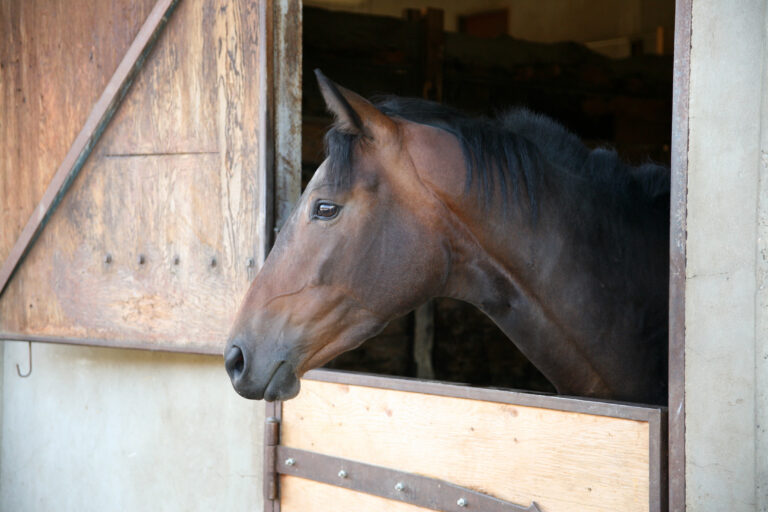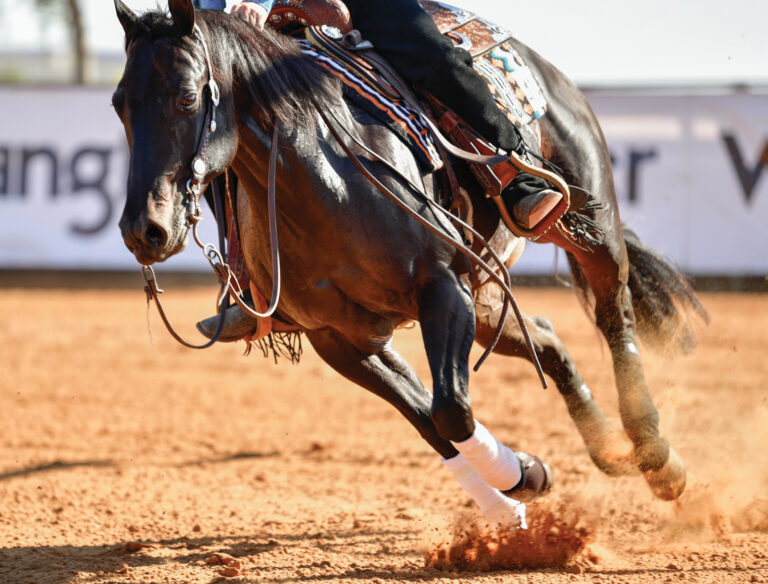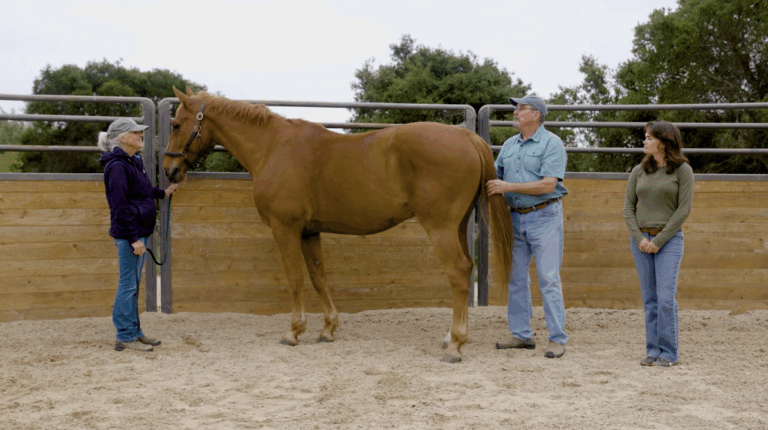There’s nothing that’ll turn your foal’s world upside down faster than separating him from his mom. Not only is she a handy snack bar (he nurses several times every hour until the age of about 17 weeks), she also provides comfort, safety, and reasonably tolerant companionship. But when it’s time to wean (often between the ages of 4 to 6 months), he’s a bit like a toddler facing his first day of preschool without a security blanket. And then, with his frantic cries and his dam’s worry, it’s hard on you, too.

Stressful Situation
Weaning stress can impact your foal’s health as he makes dietary and emotional adjustments. And, research has shown that it can impact his immunity, as well. So, how do you minimize his stress (and keep him healthy) while he makes it through this early milestone? We’ll offer four options for weaning. Your choice will depend on the number of horses you have, your facilities, personal preference, and other considerations.
So, while your foal pesters his mom and plays with his friend blissfully unaware of what’s to come, take a moment to read up on your options and decide what’ll work best.
Cold Turkey: Abrupt Weaning
How it works: Once you’ve chosen a day to wean, remove the mare from the foal completely for an extended period.
Philosophy: This is the most commonly used method for weaning. With the idea that a clean break is, in the long run, the easiest and most effective way to wean.
Prerequisites: A safe stall for containment, and/or sound, secure fences for turnout; a place to keep the mare out of earshot of her foal. If you can keep the foal in the same place and remove the mare to another location, the foal will be less stressed because he’s in a familiar environment.
Positives: The worst will probably be over after 48 hours. And this method is probably the simplest and least time-intensive from a management standpoint.
Pitfalls: Most experts agree this method is thought to produce the greatest stress for the foal (and possibly for you, as you listen to him). He’ll cry a lot, may not eat, and may even try to escape (which could lead to injury). Research shows higher blood hormone levels with “cold turkey” weaning, indicating greater stress and, often, decreased immunity and weight loss.
Should you consider it?
Maybe, if you don’t have the wherewithal to handle one of the other approaches, yet need a simple, quick method.
In real life: Leslie Weston. owns Cayuga Ridge Ranch in Trumansburg, New York. She shows and breeds Appaloosas and Quarter Horses, raising about three to five foals each year. She says that on the first day of weaning, they’ll remove the mare. “On the second day,” she adds, “We’ll turn the foal out with a familiar older mare or gelding as a babysitter. That’s worked well. By evening, foals go back to separate stalls, next to each other. There’s a lot more trauma if the mare and foal can hear each other. So we keep them at separate facilities.”
Disappearing Mare: Pasture Weaning
How it works: In advance of weaning, place three or more nursing mares and their foals in a pasture together. Include a kind, older mare or gelding. After several weeks, remove the oldest foal’s dam (or the dam with the most independent foal). Wait two to three days, and remove the next-oldest foal’s dam. Continue this process until you’ve removed all the nursing mares. And then the foals are left with the mare or gelding as a babysitter.
Philosophy: Although the mare is removed abruptly, as with cold-turkey weaning, foals are in a familiar environment. And they still have the comfort and companionship of other “mother figures” and playmates, creating a less stressful situation. While a tolerant mare may allow the weanlings to nurse, it shouldn’t be a problem, since she’ll be removed soon enough.
Prerequisites: Obviously, this won’t work for a solo mare and foal. You’ll need three or more nursing pairs, a safe pasture, and a place (out of earshot) where removed mares can be taken. As well as a babysitter mare or gelding, if possible. Positives: Most research shows this method offers the least amount of stress for the foal. It’s a relatively simple process that won’t require intensive management, and foals offer very little vocalization.
Pitfalls: The number of mares needed (and pasture space) will make it unrealistic for many mare owners. A foal could conceivably be injured if trying to nurse from an intolerant mare. But most tend to understand the “back off” behavioral language of a mare that isn’t his dam.
Should you consider it?
Yes, if you have enough space and a sufficient number of mares. And you’re looking for a method that’s low stress and not as time intensive as gradual weaning strategies.
In real life: Researchers at Virginia Tech’s Middleburg Agriculture Research and Extension Center (MAREC) checked blood hormone levels in foals. They found them to be less stressed when weaned in this way compared to the cold-turkey process. “Hands down, this would be the method to use for lower foal stress,” says Rhonda Hoffman, PhD. She is one of the authors of the study and now associate professor of horse science at Middle Tennessee State University. “We’d remove a couple of mares every two to three days. Then at the end, we always left a familiar non-nursing mare or gelding with the weanlings through the winter months. There was very little whinnying or vocalizing from the foals. They knew their mom was gone, but they were with their buddies, and they seemed to accept it more easily.”
On The Clock: Gradual Weaning
How it works: Start by removing the mare for a short period of time say 15 minutes then gradually increase the amount of time apart until the pair is separated completely.
Philosophy: Eventually, less nursing will decrease the mare’s milk supply, and the pair will gradually grow accustomed to being apart.
Prerequisites: You’ll need to be able to take the mare temporarily to a place out of earshot of the foal. Yet close enough for you to move her back and forth in increments. It’s helpful to have someone who can help you keep the foal in his stall while you remove the mare. And to monitor the foal while the mare’s gone.
Positives: It’s less stressful than abrupt methods, and may help the mare’s milk supply decrease more gradually (keeping her more comfortable). Pitfalls: Weaning is stretched over the course of several weeks, so it’s more time intensive.
Should you consider it?
Yes, if you have just one or two foals and want to wean gradually, but don’t have the option of proximity weaning (see below). Also a good option if you don’t have a different facility where you can keep your mare. Though you will need a place to take her out of earshot during weaning intervals.
In real life: Camie Heleski, PhD, coordinator for horse management at Michigan State University, says that research has found pasture weaning to be the least stressful, but the MSU program does use gradual weaning occasionally for show mares. “For someone who raises one foal each year, gradual weaning is definitely a more animal-friendly way to wean than cold turkey. We start by taking the mare out to groom. Then we’ll take her out to groom and longe, and then maybe by the end of two weeks, we’ll start keeping her out longer for riding sessions. You may have the foal and mare showing stress for short periods, over a longer stretch of time, but it’s definitely less stressful than traditional, cold-turkey weaning.”
Close For Comfort: Proximity Weaning
How it works: Provide a divider (for example, mare and foal are in adjoining pens, with a fence between them) where mare and foal can see and touch each other, but the foal can’t nurse.
Philosophy: Foal is kept from suckling, but not denied mom’s comfort and companionship, keeping stress at a minimum.
Prerequisites: Two adjacent turnout areas with safe, secure fencing, where the foal and mare can keep each other in sight.
Positives: Lower stress levels because the mare and foal see and touch each other; less time-intensive than gradual weaning. Doesn’t require you to move the mare to a different facility, so may be less disruptive to your routine.
Pitfalls: Some foals may injure themselves if the fencing isn’t safe, or the paddock has sharp objects. Foals may remain more tightly bonded to dams than if mares are removed completely. Which may make it harder to separate them later for training sessions.
Should you consider it?
Yes, if you have only one or two foals, and you’re looking for a low-stress option that doesn’t require a lot of management, as gradual weaning would. Also a good option if you don’t have an “out of earshot” location where you can keep your mare.
In real life: Michelle Stallings of Stallings Paint Horses in Aubrey, Texas, uses a combination of gradual and proximity weaning. “We’ll take the mare out and tie her in front of the stall. This is so she and the baby can see each other and touch noses,” she says. “In about four hours we’ll put the mare back in and let the baby nurse. Then, we’ll tie the mom back outside the stall for another four hours. We let them spend the night together. Usually by the third day we’ll turn the mom out and that’s it. We really stress a more natural, gradual process, because it seems like the foals are more well-adjusted that way.”
Misery Loves Company?
It’s been a long accepted practice, and one that is thought to reduce stress in weanlings: put two foals together. The philosophy has always been that “misery loves company,” and having a buddy will help ease loneliness and keep the stress levels low.
And, while studies have found that foals kept in pairs during weaning showed less stress, Virginia Tech’s Middleburg Agriculture Research and Extension Center (MAREC) checked blood cortisol (stress hormone) levels of foals during the weaning process and found just the opposite.
Foals were randomly divided, with some being confined in a stall solo, while pairs were placed in a double stall. Much to the researchers’ surprise, results showed that foals by themselves had lower levels of blood cortisol, while foals placed together were more anxious.
High Anxiety
“We found that paired foals worried each other to death. They picked and kicked at each other, and their blood cortisol levels were much higher than the solo foals,” says Rhonda Hoffman, PhD, who co-authored the study. “We kept formal records of behavior on each foal during the weaning experiments. As a result, we knew without a doubt that the foals’ behavior and the cortisol levels indicated greater stress in foals paired in stalls, compared to single foals in stalls.”
Hoffman said that wasn’t the case for groups of foals going through pasture weaning. In that case, the buddy system (and perhaps the presence of a supervising grown-up?) seems to have a positive influence on stress levels.
Something else to keep in mind about weaning in pairs? Even if those two foals get along great, you may be faced with weaning them from each other when the time comes for training and separation.
Weaning Well
- No matter which option you choose, avoid extra stress on your foal’s system during weaning by making sure he’s up-to-date on immunizations and deworming before the weaning process starts.
- If your foal will be confined to a stall, take out feeding buckets and hay feeders where possible, and make sure there isn’t anything in the stall that might cause injury.
- Make sure your foal is used to eating some sort of commercially mixed feed or hay ration. Look for a feed concentrate that includes zinc, vitamins E and C, selenium (if you’re in a selenium deficient area), and antioxidants, which will all help reduce stress. Caveat: Cornell University behaviorist Katherine Houpt, PhD, points out that some research has shown diets high in carbohydrates may encourage foals to crib. Heleski agrees that there may be a link. “Rations high in starch can drop the stomach pH making it more acidic, and that may encourage cribbing. We’re starting to question the old tradition of high grain and low forage for weanlings,” she says. “It makes them look beautiful, but they’ll probably be healthier on a quality forage.”
- Avoid layering stresses. Make sure both mare and foal are in excellent health before weaning. Heleski points out that back-to-back stress is often the reason why foals weaned in August, then taken to a futurity in September, will come home sick.
Remember This
- While your mare might be uncomfortable during weaning, don’t milk her out. You’ll signal her body to produce milk and prolong the time it takes for her to dry up. Do check to make sure she doesn’t have heat and swelling (signs of mastitis).
- Taper your mare’s grain ration gradually before weaning, then remove it for about two weeks from the day of weaning to help drop her milk supply.
- When you have a choice, keep your foal in a familiar environment during weaning, rather than moving him to a different stall or pasture. If you must move one of them, make it the mare.
- Do your halter training before weaning, not after, to ease management of the foal during weaning, and to avoid post-weaning battles. “I like to make sure the foal handles nicely in the mare’s presence before weaning,” says Heleski. “Often, the foal is really mad at the world after weaning, and that’s one of the most dangerous times to work with a foal.”
- Keep the mare and foal separate as long as possible (a month, at least). Some foals will try to resume nursing even after a lengthy separation.


![[Aggregator] Downloaded image for imported item #35942](https://s3.amazonaws.com/wp-s3-horseandrider.com/wp-content/uploads/2025/10/20105738/EDCC-Unbranded-14-300x200-1.jpeg)

